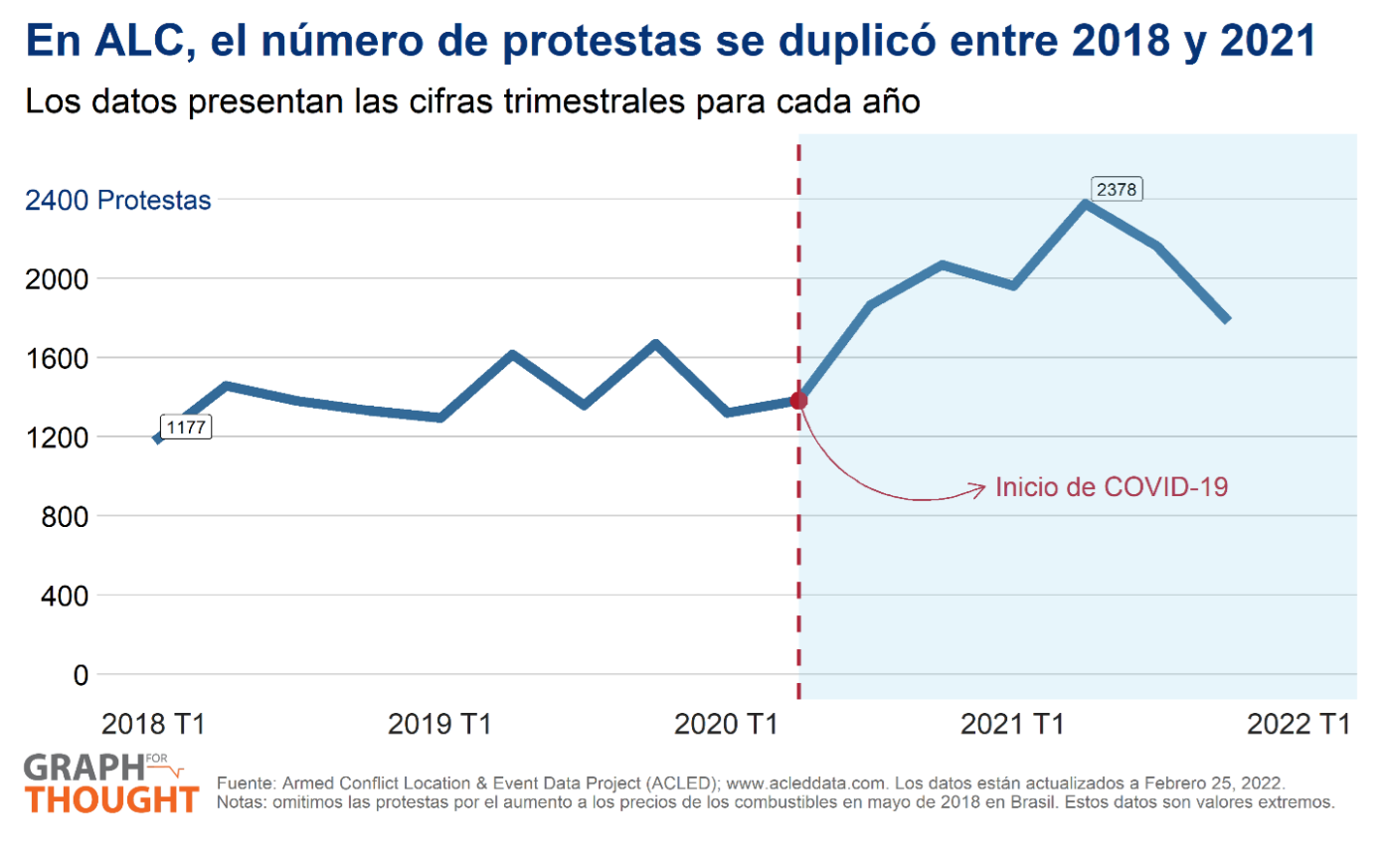Hirschman in the Tropics: Social Tensions, COVID-19 and Social Unrest in Latin America and the Caribbean
March 9, 2022
Throughout the LAC region, the last three years will be remembered as a time of discontent and social mobilization in Latin America and the Caribbean. Citizens took to the streets, and demonstrations such as those in Chile, Cuba, Brazil, Bolivia, Colombia, Ecuador, or Mexico occupied the attention of the media and generated institutional responses on different scales. While COVID-19 containment measures seemed to bring that trend to a halt, we saw social mobilizations regain attention in the second half of 2021.
Using data from ACLED[1], this #GraphForThought delves into how protests in the region have evolved since 2018. In Figure 1, we see that the number of protests has been increasing since the data is first available in the first quarter of 2018 but grows at a much faster rate after the onset of the pandemic, peaking in the second quarter of 2021. At its highest peak, the number of protests doubled compared to 2018[2].

However, this growing trend is not mirrored within countries when we disaggregate the data. Figure 2 shows trends for some of the largest countries in the region: Brazil, Chile, Colombia, and Mexico. We see that in some countries reported protests remain relatively stable, except for discrete episodes, where the number of mobilizations jumps in a short period of time, while in other countries there is a steady increase. In other words, using categories taken from the disaster risk literature, we can distinguish the “intensive” versus the “extensive” margin of protests. The intensive margin refers to the magnitude of the demonstrations in terms of number of people and visibility, while the extensive margin refers to the persistence of the demonstrations, even when they are not so visible because of their magnitude.
We can thus think of "intensive” protests as those related to high severity and medium to low frequency and "extensive” protests as those associated with low severity and high frequency. Examples of intensive events are the protests that occurred in the second quarter of 2019 and the third quarter of 2021 in Brazil; those of the last quarter of 2019 in Chile; and those of the second quarter of 2021 in Colombia. These are the protests that got extensive media coverage and received international attention. Mexico, on the other hand, is an example of “extensive” events, where the growing trend remains steady, and does not present intensive episodes during the observed period.
Intensive events are important because they are highly visible, and often are more likely to act as catalysts for institutional responses. In Chile, for example, the intensive events observed in the last quarter of 2019, eventually led to the creation of the Constituent Assembly. In Colombia, similarly, we observed intensive mobilizations during the second quarter of 2021, which dwindled with the establishment of roundtable dialogues.

Social mobilization, when non-violent, is a legitimate mechanism for citizens to express their concerns in participatory democracies. In this sense, protests can be a symptom of healthy democratic institutions and citizen participation. If institutional mechanisms are in place to process the demands that spark citizen mobilization, they can consolidate horizontal accountability mechanisms (in which systems of checks and balances are effectively institutionalized within government). However, when these mobilizations do not find the institutional mechanisms to process their demands, they can result in greater frustration and discontent and, potentially, violence.
It is essential to promote adequate and effective institutional channels to process the tensions that are intrinsic to development (Hirschman, 1958). While intensive protests are perhaps more likely to result in institutional responses, it is important to also pay attention to extensive protests - those that are likely to receive less media attention - and develop the mechanisms, at the local and national level, to address the demands that spark them.
[1] According to the ACLED technical documents, protests are defined as "non-violent demonstrations, typically involving unorganized action by members of society."
[2] Furthermore, since the start of the COVID-19 pandemic, the average growth rate of the number of protests for LAC was 5.84%, while the world growth rate was only 1.15%. Even though globally, the trend would begin to decline after the first quarter of 2021, in LAC, this would not happen until after reaching its highest point in the second quarter of that year.


 Locations
Locations